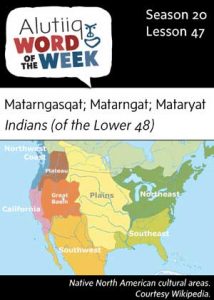 Matarngasqat; Matarngat; Mataryat–Indians (of the Lower 48)
Matarngasqat; Matarngat; Mataryat–Indians (of the Lower 48)
Matarngasqat Camani amlertut.–There are a lot of Indians in the Lower Forty-eight.
When Christopher Columbus landed in the Caribbean in 1492, he mistook the Bahamas for India and called the indigenous people he encountered Indians. The term has since come to mean an indigenous person of North America, and many people use it to refer to any person of Native ancestry. To Alaskans, however, the word Indian denotes a more specific heritage.
Anthropologists recognize three distinct populations of Native North Americans: Indians, Eskimos, and Aleuts, each with a unique biological ancestry. Alaska is the only part of North America where all three populations are present. Here, people use the term Native rather than Indian to refer generally to an indigenous person. This can be confusing for people from other parts of the continent, who sometimes incorrectly apply the term Indian to Alutiiq people, calling them Alutiiq Indians.
Although the Alutiiq people are not an Indian people, Indian cultures have contributed to Alutiiq traditions. Trade with neighboring Athabaskan and Tlingit peoples brought Indian goods, stories, artwork, and even people to Alutiiq communities. Stories suggest that the Alutiiq were aware of Indian people who lived along the Pacific Coast much farther south, perhaps through long-distance trade networks. The Alutiiq word for these people literally means “naked ones,” a reference to the different clothing styles of warmer climates.
In the early decades of the nineteenth century, Alutiiq families lived with matarngasqat at Russian posts in northern California. At Fort Ross, a settlement near Jenner, Alutiiq people worked and intermarried with Kashaya Indians. The word kashaya means “expert gambler” in a Pomoan language. Anthropologists believe that the Kashaya taught Alutiiq hunters to play kaataq, a popular guessing game they brought back to Kodiak.
Source: Alutiiq Museum
